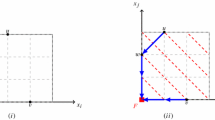Abstract
We provide an algorithm for the exact computation of the lattice width of an integral polygon K in linear-time with respect to the size of K. Moreover, we describe how this new algorithm can be extended to an arbitrary dimension thanks to a greedy approach avoiding complex geometric processings.
Supported in part by the the French National Agency of Research under contract GEODIB ANR-06-BLAN-0225-02. A preliminary version of part of this paper appeared in the proceedings of the IWCIA 2006 conference.
Chapter PDF
Similar content being viewed by others
Keywords
These keywords were added by machine and not by the authors. This process is experimental and the keywords may be updated as the learning algorithm improves.
References
Arnold, V.I.: Higher dimensional continued fractions. Regular and chaotic dynamics 3, 10–17 (1998)
Barvinok, A.: A Course in Convexity. Graduates Studies in Mathematics, vol. 54. Amer. Math. Soc, Providence (2002)
Boyce, J.E., Dobkin, D.P., Drysdale, R.L., Guibas, L.J.: Finding extremal polygons. In: STOC, pp. 282–289 (1982)
Cook, W., Hartman, M., Kannan, R., McDiarmid, C.: On integer points in polyhedra. Combinatorica 12, 27–37 (1992)
de Berg, M., Schwarzkopf, O., van Kreveld, M., Overmars, M.: Computational Geometry: Algorithms and Applications. Springer, Heidelberg (2000)
Debled-Rennesson, I., Reveillès, J.-P.: A linear algorithm for segmentation of digital curves. IJPRAI 9(4), 635–662 (1995)
Dobkin, D.P., Snyder, L.: On a general method for maximizing and minimizing among certain geometric problems. In: SFCS 1979: Proceedings of the 20th Annual Symposium on Foundations of Computer Science, Washington, DC, USA, pp. 9–17. IEEE Computer Society, Los Alamitos (1979)
Eisenbrand, F., Laue, S.: A linear algorithm for integer programming in the plane. Math. Program. Ser. A 102, 249–259 (2005)
Eisenbrand, F., Rote, G.: Fast 2-variable integer programming. In: Aardal, K., Gerards, B. (eds.) IPCO 2001. LNCS, vol. 2081, pp. 78–89. Springer, Heidelberg (2001)
Feschet, F.: The exact lattice width of planar sets and minimal arithmetical thickness. In: Reulke, R., Eckardt, U., Flach, B., Knauer, U., Polthier, K. (eds.) IWCIA 2006. LNCS, vol. 4040, pp. 25–33. Springer, Heidelberg (2006)
Feschet, F.: The lattice width and quasi-straightness in digital spaces. In: 19th International Conference on Pattern Recognition (ICPR), pp. 1–4. IEEE, Los Alamitos (2008)
Fleischer, R., Mehlhorn, K., Rote, G., Welzl, E., Yap, C.-K.: Simultaneous inner and outer approximation of shapes. Algorithmica 8(5&6), 365–389 (1992)
Harvey, W.: Computing two-dimensional Integer Hulls. SIAM Journal on Computing 28(6), 2285–2299 (1999)
Hirschberg, D., Wong, C.K.: A polynomial-time algorithm for the knapsack problem with two variables. J. Assoc. Comput. Mach. 23, 147–154 (1976)
Houle, M.E., Toussaint, G.T.: Computing the width of a set. IEEE Trans. on Pattern Analysis and Machine Intelligence 10(5), 761–765 (1988)
Hübler, A., Klette, R., Voss, K.: Determination of the convex hull of a finite set of planar points within linear time. Elektronische Informationsverarbeitung und Kybernetik 17(2/3), 121–139 (1981)
Kaib, M., Schnörr, C.-P.: The Generalized Gauss Reduction Algorithm. Journal of Algorithms 21(3), 565–578 (1996)
Kannan, R.: A polynomial algorithm for the two variable integer programming problem. J. Assoc. Comput. Mach. 27, 118–122 (1980)
Lachaud, G.: Klein polygons and geometric diagrams. Contemporary Math. 210, 365–372 (1998)
Lachaud, G.: Sails and klein polyhedra. Contemporary Math. 210, 373–385 (1998)
Lenstra, H.W.: Integer Programming with a Fixed Number of Variables. Math. Oper. Research 8, 535–548 (1983)
Lyashko, S.I., Rublev, B.V.: Minimal ellipsoids and maximal simplexes in 3D euclidean space. Cybernetics and Systems Analysis 39(6), 831–834 (2003)
Reveillès, J.-P.: Géométrie discrète, calcul en nombres entiers et algorithmique. Thèse d’etat, Université Louis Pasteur, Strasbourg, France (1991)
Rote, G.: Finding a shortest vector in a two-dimensional lattice modulo m. Theoretical Computer Science 172(1-2), 303–308 (1997)
Scarf, H.E.: Production sets with indivisibilities part i and part ii. Econometrica 49, 1–32, 395–423 (1981)
Schrijver, A.: Theory of Linear and Integer Programming. John Wiley and Sons, Chichester (1998)
Author information
Authors and Affiliations
Editor information
Editors and Affiliations
Rights and permissions
Copyright information
© 2009 Springer-Verlag Berlin Heidelberg
About this paper
Cite this paper
Charrier, É., Buzer, L., Feschet, F. (2009). Efficient Lattice Width Computation in Arbitrary Dimension. In: Brlek, S., Reutenauer, C., Provençal, X. (eds) Discrete Geometry for Computer Imagery. DGCI 2009. Lecture Notes in Computer Science, vol 5810. Springer, Berlin, Heidelberg. https://doi.org/10.1007/978-3-642-04397-0_5
Download citation
DOI: https://doi.org/10.1007/978-3-642-04397-0_5
Publisher Name: Springer, Berlin, Heidelberg
Print ISBN: 978-3-642-04396-3
Online ISBN: 978-3-642-04397-0
eBook Packages: Computer ScienceComputer Science (R0)





